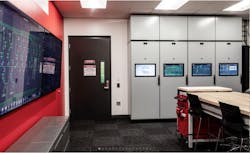Cummins has announced the launch of a new microgrid test lab that will allow the company’s engineers and technical partners to assess and optimize the performance of complex microgrid systems.
Located at the Cummins Power Generation facility in Fridley, Minnesota, the 20,000 square foot Cummins Power Integration Center (PIC) cost more than $5 million and took around 18 months to complete.
It features an outdoor test area with five 500-kW test pads and two 2,000-kW test pads, a main switchgear room, an electrical mezzanine with solar and storage testing areas, and an engineering control room. The lab also features a 500-kW roof-mounted photovoltaic system, two 500-kW programmable load banks and alternating current and direct current control power.
Why build a microgrid test lab?
Prior to the launch, Gary Johansen, vice president of power systems engineering at Cummins, told Microgrid Knowledge that recent technology and market changes were key factors driving the company’s investment in this space. “We saw the investments that were going to be needed, both in our products and our solutions and how we bring those products to the market,” Johansen said.
In recent years, Cummins has developed solutions for emergency standby applications as well as prime power applications where microgrids can be operated as islands, as grid-connected solutions or both. “We’re starting to see this continual blurring of the line between pure standby and pure prime power,” Johansen said.
He added that the need for the lab grew clear as more renewable energy was integrated into their solutions.
One such example is the microgrid at Fisherman’s Landing Marina in British Columbia, Canada. The marina needed a microgrid solution to reduce operating costs and maximize efficiency. The microgrid includes a large solar array to fully power operations during lower demand periods, as well as Cummins control and switchgear technology. Cummins also supplied three diesel generator sets to support the facility during peak demand periods.
Optimization and validation in the lab
Cummins designed the PIC space to be flexible and modular, allowing the company to quickly integrate a variety of energy sources including battery energy storage systems, diesel and natural gas generators, fuel cells and the grid.
Once the power sources are configured, they can then test the system at a variety of different loads.
“It’s really a plug-and-play architecture that allows you to bring in these different sources to coexist very quickly,” according to Johansen. They can then modify the microgrid design to “optimize the performance of those attributes that are most critical.”
Not only will the lab allow Cummins to test its own technological advancements, but it will also give the company a place to demonstrate to its customers that a system will work as intended. It’s a way to verify and validate the solution’s ability to deliver the performance and capability the customer expects, according to Johansen.
De-risking microgrid projects
Wissam Balshe, director of energy management solutions for Cummins, told Microgrid Knowledge that one of the biggest challenges for microgrid project developers is the time and expense associated with systems integration of various power systems. He says the new Cummins Power Integration Center helps developers de-risk their microgrid projects, especially those being developing under energy as a service contracts.
According to Balshe, the Cummins Power Integration Center will allow customers and developers to go beyond the modeling they’re currently doing with software or hardware in the loop methods and physically test a wide combination of power assets. Ultimately, Balshe believes the PIC will reduce commissioning time and help eliminate many of the costly onsite integration changes required for a successful deployment.
Another step toward net zero
The microgrid lab is just one of many investments Cummins is making to reach its 2050 net zero goal. “We’re investing in a lot of new technologies like fuel cells, hydrogen generation and mobile and stationary hybrid solutions for industrial and power gen applications,” said Johansen.
Cummins plans to bring partners and customers into the lab for joint project work.
Track news about microgrid test systems. Subscribe to the free Microgrid Knowledge Newsletter.








